14 – 15 September 2017
Somerset House, King’s College London
By Dr Sarah Carter-Walshaw
The Ethics and Regulation of in Vitro Gametogenesis (IVG) symposium was jointly organised by Dr César Palacios-González (King’s College London), Professor Rosamund Scott (King’s College London) and Professor Stephen Wilkinson (Lancaster University). It was attended by scientists (including those engaged in IVG-related research), clinicians, members of the Progress Educational Trust, Human Fertilisation and Embryology Authority, and of the Nuffield Council on Bioethics, academics working in philosophy, ethics, and law, and by. The event was part of a programme of research and events on new reproductive technologies supported by a Wellcome Trust Senior Investigator Award held jointly by Professors Scott and Wilkinson, entitled ‘The Donation and Transfer of Human Reproductive Materials’.
Session 1: Science and Regulatory Panel
This session focused principally on scientific aspects of IVG, with some attention also to regulatory matters. It was chaired by Professor Bobbie Farsides (Professor of Clinical and Biomedical Ethics at the Brighton and Sussex Medical School; Member, HFEA) who invited comments, following the two talks detailed below, from a panel made up of Dr Andy Greenfield (Medical Research Council (MRC) Harwell Institute; Member, HFEA and Nuffield Council on Bioethics), Professor Peter Braude (King’s College London, Women’s Health, Emeritus), and Ms Sarah Norcross (Director of Progress Educational Trust).
Professor Azim Surani: ‘Human Germline: A New Research Frontier’
(Director of Germline and Epigenomics Research, Wellcome Trust Cancer Research UK, Gurdon Institute, University of Cambridge)
Professor Surani explained that research on human germ cells (as opposed to mice) is at a relatively early stage and that we have only recently begun to see where human germ cells might originate, and their properties. Further, we must be alert to the differences between mouse and human development, such as the time of gestation (20 days for mice as opposed to 288 for humans), the time at which primordial germ cells begin to develop, and the genes that play a key role in development. Acknowledging legal issues in embryo development research, Surani noted that pig embryo development is closer to that of humans; this can be used as a surrogate for some research into human embryo development, as the same key genes are involved in primordial germ cell development in both species. Together these models are improving understanding of human germ cell development.
Surani went onto explain that researchers are now making use of the increasing knowledge of the human germline for bioinformatics analysis to understand the development of human primordial germ cells, and that we now have relatively detailed information on the process up to about week 10 of development. With regards to developing IVG research, the first objective would involve development of primordial germ cells that reach a stage equivalent to around the 7-9th week when they enter the gonads and commence gametogenesis. This will be a challenging task. He closed by describing his current collaborative work with Professor Lovell-Badge, making gonadal cells in culture to support the development of human primordial germ cells, and noted the importance of ‘resetting’ and erasure of epigenetic memory at this stage of primordial germ cell development.
Professor Robin Lovell-Badge: ‘Towards obtaining in vitro-derived gametes and their potential uses’
(Senior Group Leader and Head of the Laboratory of Stem Cell Biology and Developmental Genetics at the Francis Crick Institute in London, UK)
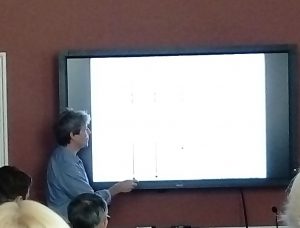 Professor Lovell-Badge began by noting the different places from which stem cell-derived gametes could be derived: embryonic stem cells (be they from embryos produced by IVF or somatic cell nuclear transfer (SCNT)) or iPSCs (induced pluripotent stem cells). Other methods of obtaining gametes, such as the use of spermatogonial stem cells from the testis or primordial follicles in the ovary, and the direct reprogramming of somatic cells, were also discussed. He explained that the somatic environment impacts on the sex of the germ cells, so that a primordial germ cell put into a testis will proceed along the path to become a sperm cell, but in an ovary it will become an egg cell. In terms of in vitro production of oocytes or sperm entirely in vitro from pluripotent stem cells, Lovell-Badge discussed in vitro co-culture with ovarian or testicular somatic cells: methods which seem promising, as indicated by research by, for example, Hikabe and colleagues in Nature (2016)[1].
Professor Lovell-Badge began by noting the different places from which stem cell-derived gametes could be derived: embryonic stem cells (be they from embryos produced by IVF or somatic cell nuclear transfer (SCNT)) or iPSCs (induced pluripotent stem cells). Other methods of obtaining gametes, such as the use of spermatogonial stem cells from the testis or primordial follicles in the ovary, and the direct reprogramming of somatic cells, were also discussed. He explained that the somatic environment impacts on the sex of the germ cells, so that a primordial germ cell put into a testis will proceed along the path to become a sperm cell, but in an ovary it will become an egg cell. In terms of in vitro production of oocytes or sperm entirely in vitro from pluripotent stem cells, Lovell-Badge discussed in vitro co-culture with ovarian or testicular somatic cells: methods which seem promising, as indicated by research by, for example, Hikabe and colleagues in Nature (2016)[1].
Lovell-Badge also discussed cross-sex gametes and the role of sex chromosomes in fertility, stating that XX males are always sterile (as XX cannot give rise to sperm in vivo because XX is incompatible with early postnatal stages of spermatogenesis) and further that, while there are some reports of XY women with fertility, it is unclear if they are mosaic, as almost all are infertile. He explained further that acquiring sperm from an individual with XX chromosomes and eggs from a person with XY would probably require manipulation of sex chromosomes and/or several specific genes. As such, it may instead be better to go through in vitro methods rather than gene editing in order to avoid this. Lovell-Badge spoke as well about Klinefelter syndrome (where patients have XXY chromosomes and are often infertile), where recent studies in mice show that iPSCs derived from XXY animals tend to lose a sex chromosome to give either XY or XX cells, which can then be used to derive functional gametes. He noted that patients with this syndrome could have both XY and XX germ cells, and so could theoretically have their own children, although this would be very unwise.
Session 2
Professor Sonia Suter: ‘The Tyranny of Choice’
(Professor of Law at the George Washington University Law School, The George Washington University)
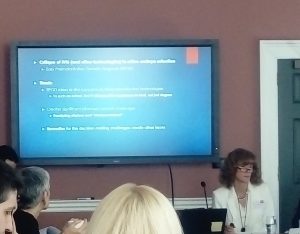 Professor Suter discussed the possible future use of IVG (alongside other reproductive technologies) in pursuit of what Greely terms ‘Easy PGD’[2] and the ethical and practical issues arising here, especially with regard to choice. In ‘Easy PGD’, IVG is used to produce vast numbers of sperm and egg cells, from which a similarly large number of embryos are created. Whole genome sequencing and preimplantation genetic diagnosis techniques are then used to obtain the genetic profile of each embryo, allowing clinicians or prospective parents to select embryos on the basis of detailed ‘embryo profiling’. This possibility not only raises questions regarding inequality, prejudice, and commodification, but also may lead to prospective parents becoming overloaded with information and choice. Suter explained further that selecting embryos will be more difficult in this instance as not only will there be large amounts of information available for each embryo (once they have undergone whole genome sequencing) but that this scale of information will then be multiplied by the vast number of embryos made through IVG. As a result, parents will face ‘choice overload’ and would have to consider extremely complicated trade-offs.
Professor Suter discussed the possible future use of IVG (alongside other reproductive technologies) in pursuit of what Greely terms ‘Easy PGD’[2] and the ethical and practical issues arising here, especially with regard to choice. In ‘Easy PGD’, IVG is used to produce vast numbers of sperm and egg cells, from which a similarly large number of embryos are created. Whole genome sequencing and preimplantation genetic diagnosis techniques are then used to obtain the genetic profile of each embryo, allowing clinicians or prospective parents to select embryos on the basis of detailed ‘embryo profiling’. This possibility not only raises questions regarding inequality, prejudice, and commodification, but also may lead to prospective parents becoming overloaded with information and choice. Suter explained further that selecting embryos will be more difficult in this instance as not only will there be large amounts of information available for each embryo (once they have undergone whole genome sequencing) but that this scale of information will then be multiplied by the vast number of embryos made through IVG. As a result, parents will face ‘choice overload’ and would have to consider extremely complicated trade-offs.
Suter went on to consider possible ways of dealing with the problem of choice overload. One involved categorising information into different groups to aid patient understanding: e.g. physical, intellectual, psychiatric, and so on. Another entailed a professional guidelines approach, wherein professionals decide what information is relevant for disclosure (for instance, they could limit information to medically relevant conditions). A third option involved using algorithms – individual and generic. This method could enhance decision-making by making information more manageable and could be seen as more rational than choosing without such an aid. However, the use of individual algorithms presumes some understanding and clarity as to what the patient actually wants, while the use of generic algorithms would carry its own risks and ethical issues, such as possible abdication of decision-making, underlying biases, reduction in diversity, and commodification.
Professor John Harris: ‘Genetic Inheritance, Future People and Future Worlds’
(Visiting Professor in Bioethics at the Department of Global Health & Social Medicine, King’s College London; The University of Manchester)
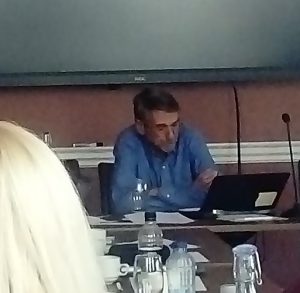 Professor Harris stated that modern bioethics, centred on science, technology, and policy, is well-illustrated by two important and current debates: human enhancement, and questions around human reproduction and genetic inheritance. With regards to germline interventions, he explained that perceptions are changing, as illustrated by the UK decision to permit mitochondrial replacement techniques (MRT). Further, MRT is now considered to be ‘safe enough’, but what is ‘safe enough’ depends on context and always requires a risk-benefit calculation. A common argument against germline interventions is that they are problematic because they will affect ‘generations down the line’; Harris replied that this is true of all reproduction, whether assisted or not. He went on to argue that consent is irrelevant in germline interventions such as CRISPR/Cas9 because there are no people in existence who can give or withhold consent to such changes in their germline, or indeed in the germline that they would inherit. Also, we already make decisions for future people (e.g. about where they will live) without raising concern about their lack of consent; he argued as well that this disregard of consent is necessary, as otherwise the resultant child would never exist in the first place.
Professor Harris stated that modern bioethics, centred on science, technology, and policy, is well-illustrated by two important and current debates: human enhancement, and questions around human reproduction and genetic inheritance. With regards to germline interventions, he explained that perceptions are changing, as illustrated by the UK decision to permit mitochondrial replacement techniques (MRT). Further, MRT is now considered to be ‘safe enough’, but what is ‘safe enough’ depends on context and always requires a risk-benefit calculation. A common argument against germline interventions is that they are problematic because they will affect ‘generations down the line’; Harris replied that this is true of all reproduction, whether assisted or not. He went on to argue that consent is irrelevant in germline interventions such as CRISPR/Cas9 because there are no people in existence who can give or withhold consent to such changes in their germline, or indeed in the germline that they would inherit. Also, we already make decisions for future people (e.g. about where they will live) without raising concern about their lack of consent; he argued as well that this disregard of consent is necessary, as otherwise the resultant child would never exist in the first place.
Harris closed his talk with reference to transgenerational epigenetic inheritance, stating that we too often lose sight of the fact that germline interventions are not the only way in which heritable changes are made. We must also recognise that we are all products of the gradual germline-altering process of evolution, which will only end come the extinction of our species. He noted Stephen Hawking’s prediction that humankind may one day need to escape the Earth in order to survive and stated that in order to enhance our ability to do this we must seek to improve human nature in ways that are ‘safe enough’, but asked as well what methods can be considered ‘safe enough’ given what is at stake. Being too cautious may lead to us stifle scientific progress, but being too reckless could also lead to disaster.
Session 3
Professor I Glenn Cohen: ‘IVG in the US: Regulatory mechanics, ethical issues and porous borders’
(Professor of Law and Faculty Director at the Petrie-Flom Centre for Health Law Policy, Biotechnology & Bioethics, Harvard University)
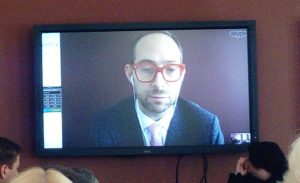 Professor Cohen identified a number of ethical issues that will have to be considered ahead of the advent of IVG technology, for instance: safety and the disruption of the market for human eggs (in particular questions raised by ‘embryo farming’ and the fact that IVG would avoid the impact of egg harvesting on women). Linked to this, Cohen noted that interesting ethical and legal questions could be raised with regards to unauthorised parentage and IVG. He illustrated this concern with the hypothetical case of Brad Pitt in the bathtub; imagine that the actor leaves behind some skin cells, which are then collected without his knowledge or consent by a woman who then utilises IVG in order to acquire gametes with his DNA, and uses these to have a child who is genetically related to him. What rights and obligations would the Brad Pitt have in such a case and how should we legislate and regulate to deal with such scenarios?
Professor Cohen identified a number of ethical issues that will have to be considered ahead of the advent of IVG technology, for instance: safety and the disruption of the market for human eggs (in particular questions raised by ‘embryo farming’ and the fact that IVG would avoid the impact of egg harvesting on women). Linked to this, Cohen noted that interesting ethical and legal questions could be raised with regards to unauthorised parentage and IVG. He illustrated this concern with the hypothetical case of Brad Pitt in the bathtub; imagine that the actor leaves behind some skin cells, which are then collected without his knowledge or consent by a woman who then utilises IVG in order to acquire gametes with his DNA, and uses these to have a child who is genetically related to him. What rights and obligations would the Brad Pitt have in such a case and how should we legislate and regulate to deal with such scenarios?
Cohen then went on to consider medical (or “circumvention”) tourism; he explained that this has already been seen with mitochondrial replacement technologies (citing the Zhang case), and suggested that we may see something like this come the advent of IVG. Cohen concluded his talk by noting further concerns that could be raised with regard to the impact on the gene pool and the difficulty that circumvention tourism poses for national regulatory approaches in this regard.
Session 4
Dr Saskia Hendriks: ‘In vitro gametogenesis: stakeholders’ perspectives’
(PhD Candidate, Academisch Medisch Centrum, Amsterdam University)
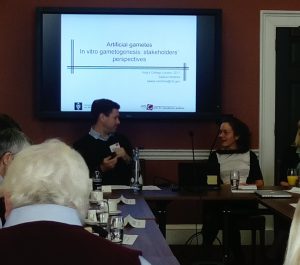 Dr Hendriks began by demonstrating, with reference to a paper that she had co-authored, that IVG technology is indeed wanted by potential patients; in her research, couples seeking fertility treatment indicated that they would consider using IVG, as long as it was safe and effective. Further work by Hendriks and colleagues explored what reasons people might have for being for or against IVG by performing a systematic literature review and conducting interviews via a cross-sectional survey. In the survey, Hendriks included all advantages and disadvantages that had been found through the literature review and asked respondents to identify which of these they felt to be most important. According to the survey, top-perceived advantages of IVG included the prevention of ovarian hyperstimulation syndrome, curing infertility, and preventing exploitation of gamete donors; top disadvantages included safety concerns and the risk of misuse of the technology. The survey also gauged the approval for different uses of IVG; for instance, 94% of the public were in favour of IVG for infertile people/couples, but far fewer were in favour of the technology being used by older (post-reproductive age) couples or by single persons where the individual would be the sole genetic parent.
Dr Hendriks began by demonstrating, with reference to a paper that she had co-authored, that IVG technology is indeed wanted by potential patients; in her research, couples seeking fertility treatment indicated that they would consider using IVG, as long as it was safe and effective. Further work by Hendriks and colleagues explored what reasons people might have for being for or against IVG by performing a systematic literature review and conducting interviews via a cross-sectional survey. In the survey, Hendriks included all advantages and disadvantages that had been found through the literature review and asked respondents to identify which of these they felt to be most important. According to the survey, top-perceived advantages of IVG included the prevention of ovarian hyperstimulation syndrome, curing infertility, and preventing exploitation of gamete donors; top disadvantages included safety concerns and the risk of misuse of the technology. The survey also gauged the approval for different uses of IVG; for instance, 94% of the public were in favour of IVG for infertile people/couples, but far fewer were in favour of the technology being used by older (post-reproductive age) couples or by single persons where the individual would be the sole genetic parent.
Regarding genetic parenthood, research suggests that there is no difference between the wellbeing of donor-conceived children and of children in genetically-related families. Yet Hendriks and colleagues found that, of patients undergoing fertility treatment, 97% of women and 99% of men wanted a genetically-related child (although both genders indicated that they felt it more important that a child be genetically related to their partner than to themselves). In another study, Hendriks undertook a discrete choice experiment and found that genetic relatedness did not have a significant impact on people’s hypothetical treatment choices in a multidimensional model, and that people were willing to trade off for example pregnancy rates and cheaper costs, with genetic relatedness. Hendriks concluded that patients might be disinclined to pursue IVG – even at the cost of genetic relatedness – if it is risky, expensive, or ineffective.
Seppe Segers: ‘IVG, Genetic Ties and the Wish for a Child with Particular Traits’
(PhD candidate, Bioethics Institute Ghent, Ghent University)
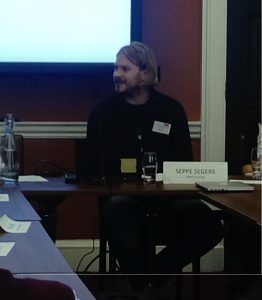 Segers discussed ‘designer babies’ and their relation to IVG. He began by noting some concerns already raised in the literature on this topic, such as eugenics, the detriment to the resultant child’s right to an open future, and the concerns not only that that this seems to go against the intuition that children should be loved unconditionally, but also that it could lead to discrimination against those with ‘disfavoured’ traits. He then considered some ways in which IVG technology could be utilised to create designer babies; for instance, ‘in vitro eugenics’ (as introduced by Sparrow), ‘Easy PGD’ (as discussed by Greely), and combining IVG with genome editing techniques.
Segers discussed ‘designer babies’ and their relation to IVG. He began by noting some concerns already raised in the literature on this topic, such as eugenics, the detriment to the resultant child’s right to an open future, and the concerns not only that that this seems to go against the intuition that children should be loved unconditionally, but also that it could lead to discrimination against those with ‘disfavoured’ traits. He then considered some ways in which IVG technology could be utilised to create designer babies; for instance, ‘in vitro eugenics’ (as introduced by Sparrow), ‘Easy PGD’ (as discussed by Greely), and combining IVG with genome editing techniques.
There is a presumption that ‘designer babies’ are morally problematic; as it seems that IVG might provide the means to create these, Segers asked what we should do about IVG as a result. He considered two possible options. The first option would be to ban the use of IVG; however, this might be an overreaction as IVG is neither sufficient nor necessary for creating ‘designer babies’ (though the fact remains that IVG could facilitate their creation). The second option would be to regulate IVG: we do not ban PGD because it could be used for non-medical use – instead regulation is used – so perhaps the same balance of risk and benefit should be applied to IVG. This would be consistent with other assisted reproduction technologies and would mean that the value of genetic relatedness would be respected as well. With regard to genetic relatedness, Segers explored whether the general importance that is accorded to genetic relatedness in parent-child relationships might conflict with a position that opposes the creation of designer offspring. One of the reasons for preferring to have genetically related offspring is the value of parent-child resemblance. He noted that this preference for resemblance can also be considered as a striving for a child with specific characteristics one desires this child to have. Segers also suggested that genetic relatedness could be considered as much a specification of a child as ‘brown-eyed’ or ‘male’ and wondered why the former would be morally acceptable in contrast to preferences about other non-disease related traits. Segers concluded by reiterating that IVG would be neither necessary nor sufficient for the creation of ‘designer babies’ but that it may facilitate it. However, that it may facilitate this endeavour should not be grounds for undermining the development of IVG technology.
Session 5
Dr Birgit Beck: ‘(Why) would it be wrong to create children without genetic parents’
(Assistant Professor, Technische Universität Berlin, Faculty I – Humanities)
Dr Beck explained Sparrow’s view that it will one day be possible (through IVG) to create children who are direct descendants of early embryos and who would therefore be ‘orphaned at conception’. Beck identified three areas in which this idea could be considered to be problematic: terminologically, metaphysically, and morally. First, Sparrow’s use of the word ‘orphan’ in this context is rather different to the way in which we would normally understand it, and so seems to be used here as a terminological placeholder. Second, under Douglas’ account of genetic relatedness, genetic parenthood requires that genetic material was inherited by the child from their parent(s) and also that the material was not transmitted from parent to child via another individual human being. This then raises the question as to whether an early embryo could be considered an individual human being, for if not then the embryos used in IVG would not qualify as an interim generation, and so it would be nonsensical to talk of children ‘orphaned at conception’.
If we were instead to argue that early embryos would be considered individual human beings (and so qualify as interim generations under Douglas’ account), we then come to the moral question: (why) would it be wrong to create children without genetic parents? One could argue (as Palacios-González, Harris, and Testa do) that creating a genetic orphan would not be morally wrong, as they would not have existed otherwise. However Sparrow and Velleman disagree, arguing that it would (most likely) be wrong to create children without genetic parents because of the risk that the children would face psychological obstacles in the development of their personality and identity, and feel grief at being unable to learn about their parents. As such, Beck concluded, answers to the titular question will vary depending on one’s conceptual, ontological, and ethical commitments.
Professor Henry Greely: ‘IVG: The Broad Implications’
(Professor of Law and Professor (by courtesy) of Genetics at Stanford University; Director of the Centre for Law and the Biosciences; Chair of the Steering Committee of the Stanford Center for Biomedical Ethics; and Director of the Stanford Program in Neuroscience and Society, Stanford University)
In his book The End of Sex, Greely predicted that in 20-40 years, most people with good health care coverage will conceive in a clinic, have whole genome sequencing of around 100 embryos, and from these select and transfer an embryo in a process he calls ‘Easy PGD’. In order to acquire 100 embryos, 100 eggs would be required, which would involve egg harvesting (which can be painful and risky) on a massive scale. Greely explained that the ‘easy’ part of Easy PGD is that those women would use IVG instead of having their eggs harvested;[3] further, women do not produce many eggs through egg harvest but, with IVG, indeterminate numbers of eggs could be made. Greely suggested that the attraction of Easy PGD for most people will be having children without harmful conditions; as a result, for those people, information regarding nonmedical traits might serve only as a ‘tie-breaker’ in selecting between embryos. Further, Easy PGD would save money for governments and the health industry in the long-term and so may be offered to patients for free.
Greely asked what the benchmark would be for safety, as perfection would of course be impossible. He suggested that, as well as doing extensive work with non-human animals, including possibly other great apes, we could perhaps create IVG embryos and then compare these to embryos created through IVF. Of course, the question would then be raised as to how closely IVG embryos would need to resemble IVF embryos in order to be considered safe. He also noted issues around the risk of choice overload for patients in Easy PGD and asked how they would be helped to make decisions in this context, and by whom (noting a need for honest and fair guidelines). Greely concluded his talk by comparing the selection of embryos through Easy PGD with controlling the weather (’If we could control the weather should we?’ ‘How much is too much rain?’ Etc.), and stating that we often feel a greater sense of responsibility when we intervene than when we leave the results to nature, or to chance.
Notes
[1] Hikabe, O, Hamazaki, N, Nagamatsu, G, Obata, Y, Hirao, Y, Hamada, N, Shimamoto, S, Imamura, T, Nakashima, K, Saitou, M, Hayashi, K (2016) ‘Reconstitution in vitro of the entire cycle of the mouse female germ line’, Nature; doi:10.1038/nature20104.
[2] Greely, HT (2016) The End of Sex and the Future of Human Reproduction; Harvard University Press: London, UK.
[3] And also for any men who are unable to retrieve sperm without medical assistance.
_____
Click here to return to the events page.